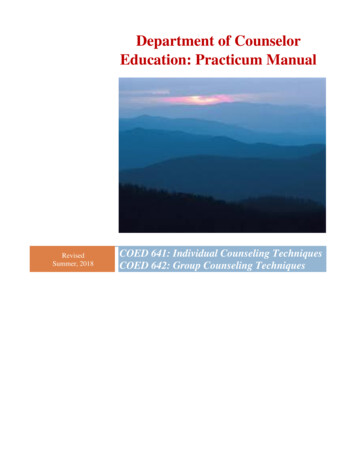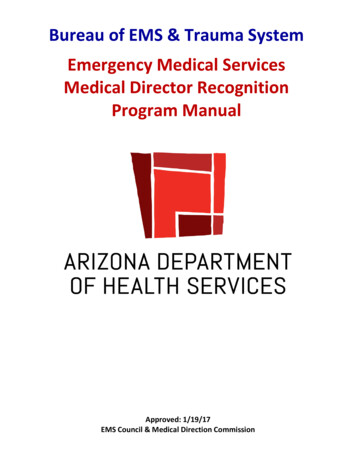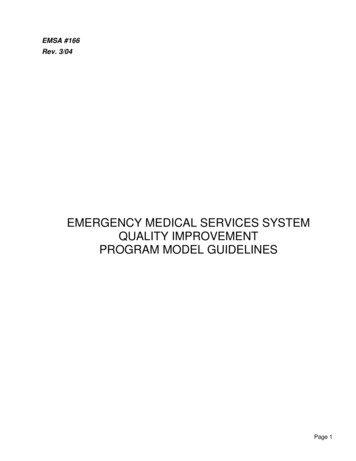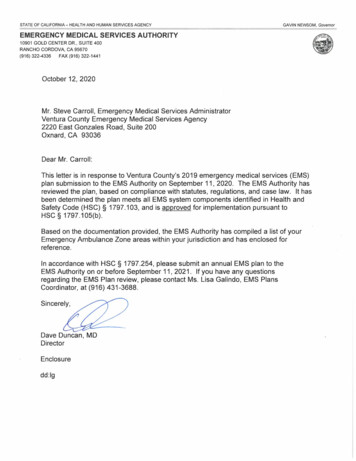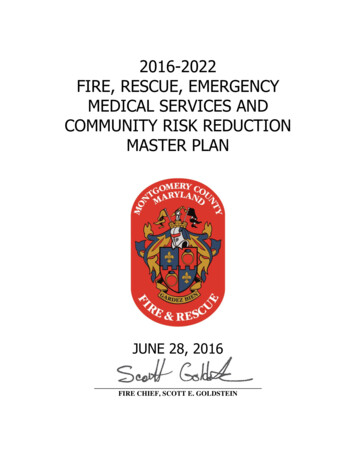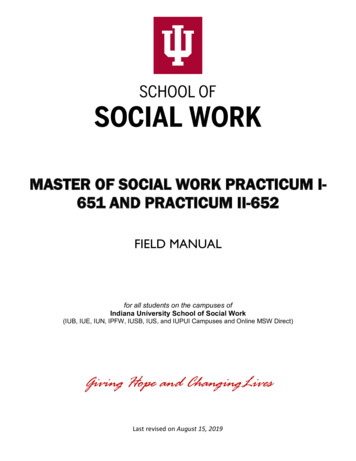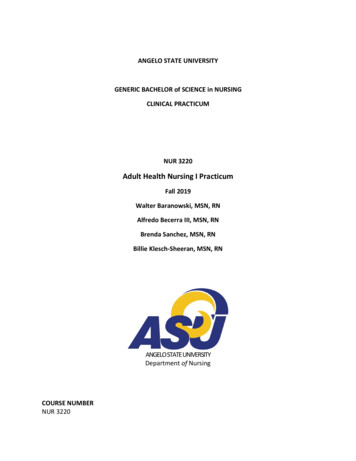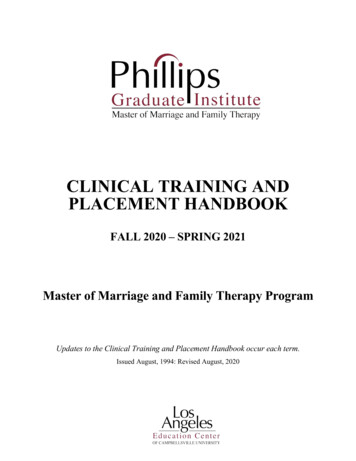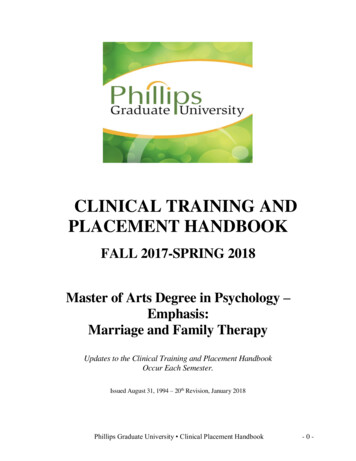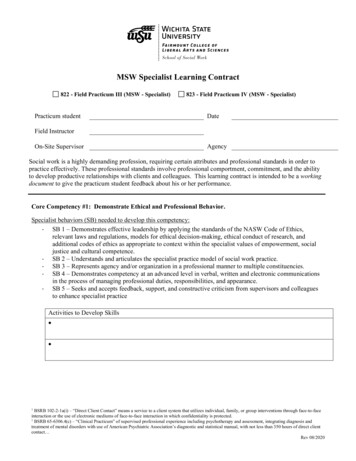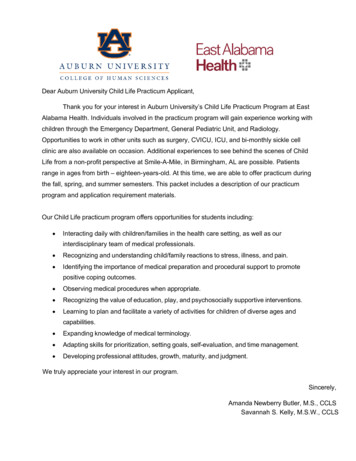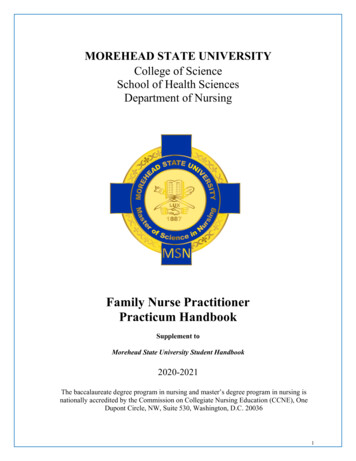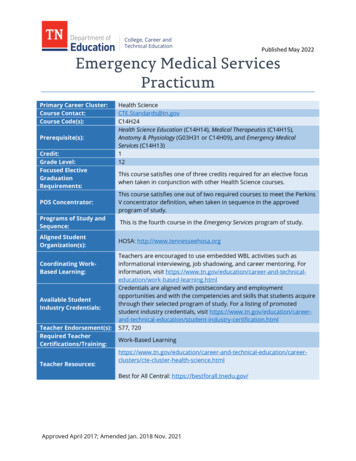
Transcription
Published May 2022Emergency Medical ServicesPracticumPrimary Career Cluster:Course Contact:Course Code(s):Prerequisite(s):Credit:Grade Level:Focused ElectiveGraduationRequirements:Health ScienceCTE.Standards@tn.govC14H24Health Science Education (C14H14), Medical Therapeutics (C14H15),Anatomy & Physiology (G03H31 or C14H09), and Emergency MedicalServices (C14H13)112This course satisfies one of three credits required for an elective focuswhen taken in conjunction with other Health Science courses.POS Concentrator:This course satisfies one out of two required courses to meet the PerkinsV concentrator definition, when taken in sequence in the approvedprogram of study.Programs of Study andSequence:This is the fourth course in the Emergency Services program of study.Aligned StudentOrganization(s):HOSA: http://www.tennesseehosa.orgCoordinating WorkBased Learning:Available StudentIndustry Credentials:Teacher Endorsement(s):Required TeacherCertifications/Training:Teacher Resources:Teachers are encouraged to use embedded WBL activities such asinformational interviewing, job shadowing, and career mentoring. Forinformation, visit ducation/work-based-learning.htmlCredentials are aligned with postsecondary and employmentopportunities and with the competencies and skills that students acquirethrough their selected program of study. For a listing of promotedstudent industry credentials, visit ducation/student-industry-certification.html577, 720Work-Based h-science.htmlBest for All Central: https://bestforall.tnedu.gov/Approved April 2017; Amended Jan. 2018 Nov. 2021
Course at a GlanceCTE courses provide students with an opportunity to develop specific academic, technical, and 21stcentury skills necessary to be successful in career and in life. In pursuit of ensuring every student inTennessee achieves this level of success, we begin with rigorous course standards which feed intointentionally designed programs of study.Students engage in industry relevant content through general education integration andexperiences such as career & technical student organizations (CTSO) and work-based learning (WBL).Through these experiences, students are immersed with industry standard content and technology,solve industry-based problems, meaningfully interact with industry professionals, and use/produceindustry specific, informational texts.Using a Career and Technical Student Organization (CTSO) in Your ClassroomCTSOs are a great resource to put classroom learning into real-life experiences for your studentsthrough classroom, regional, state, and national competitions, and leadership opportunities. Beloware CTSO connections for this course, note this is not an exhaustive list. Participate in CTSO Fall Leadership Conference to engage with peers by demonstratinglogical thought processes and developing industry specific skills that involve teamwork andproject management Participate in contests that highlight job skill demonstration; interviewing skills; communityservice activities, extemporaneous speaking, and job interview Participate in leadership activities such as Organizational Leadership, Prepared Speaking,HOSA Service Project, Creative Problem Solving, and HOSA Service Project.For more ideas and information, visit Tennessee HOSA at http://www.tennesseehosa.org/Using Work-based Learning in Your ClassroomSustained and coordinated activities that relate to the course content are the key to successful workbased learning. Possible activities for this course include the following. This is not an exhaustive list. Internship required for credential or entry occupation Apprenticeship On-the-job trainingFor more ideas and information, visit ducation/work-based-learning.html.May 2022 Page 2
Course DescriptionEmergency Medical Services Practicum is a capstone course in the Emergency Services program of studythat provides a practicum experience for students as they develop an understanding of professionaland ethical issues. The capstone course will be based on the knowledge and skills from previouscourses in the Emergency Services program of study. Upon completion of the course, students will beproficient in components of communication, critical thinking, problem solving, informationtechnology, ethical and legal responsibilities, leadership, and teamwork. Instruction may bedelivered through school-based laboratory training or through work-based learning arrangementssuch as cooperative education, mentoring, and job shadowing.Work-Based Learning FrameworkInternship standards outlined below may take the form of work-based learning (WBL) opportunities(such as internships, cooperative education, service learning, and job shadowing) or industry-drivenproject-based learning. These experiences must comply with the Work-Based Learning Frameworkguidelines established in SBE High School Policy 2.103. As such, this course must be taught by ateacher with an active WBL Certificate issued by the Tennessee Department of Education and followpolicies outlined in the Work-Based Learning Policy Guide available online ng .The Tennessee Department of Educationprovides a Personalized Learning Plan template to ensure compliance with the Work-Based LearningFramework, state and federal Child Labor Law, and Tennessee Department of Education policies,which must be used for students participating in WBL opportunities.Program of Study ApplicationThis is the capstone course in Emergency Medicine program of study, providing an opportunity for aninternship experience. For more information on the benefits and requirements of implementingthese programs in full, please visit the Health Science website nce.htmlCourse RequirementsThis capstone course aligns with the requirements of the Work-Based Learning Framework(established in Tennessee State Board High School Policy), with the Tennessee Department ofEducation’s Work-Based Learning Policy Guide, and with state and federal Child Labor Law. As such,the following components are course requirements:Course Standards1. Personalized Learning Plan1.1 Personalized learning plan: A student will have a Personalized Learning Plan that identifiestheir long-term goals, demonstrates how the Work-Based Learning (WBL) experience alignswith their elective focus and/or high school plan of study, addresses how the student plansto meet and demonstrate the course standards, and addresses employability skillattainment in the following areas:a. Application of academic and technical knowledge and skills (embedded in coursestandards)May 2022 Page 3
b. Career knowledge and navigation skillsc. 21st Century learning and innovation skillsd. Personal and social skills2. Safety2.1 Safety and universal precautions: Identify safety hazards in the workplace and demonstratepractices for safe working. Accurately read, interpret, and demonstrate adherence tosafety guidelines, including but not limited to guidelines pertaining to electrical safety,infection control, Occupational Safety and Health Administration (OSHA), chemical and backsafety. Be able to distinguish between the guidelines and explain why certain guidelinesapply. Recognize the need for and employ universal precautions to 100% accuracy.3. Postsecondary and Career Preparation3.1 Postsecondary education and credentials: Research the range of credentials one can earnwithin the Emergency Medical Service (EMS) system. Investigate both in-state and out-ofstate postsecondary programs in a variety of EMS fields.3.2 Professional resume: Search for the resumes of EMS professionals retrieved from thewebsites of systems, companies, organizations, or professional networks. Discuss what istypically included in the resumes of these professionals, compare and contrast severalexamples, and create a personal resume modeled after elements identified in the search.3.3 Job search, application, and cover letter: Simulate the experience of conducting a job searchby researching local employment options. In preparation for a future career in EMS,complete an authentic job application form and compose a cover letter followingguidelines specified in the vacancy announcement.3.4 Mock interview and thank you letter: Participate in a mock interview. Prior to the interview,research tips on dress and grooming, most commonly asked interview questions,appropriate conduct during an interview, and recommended follow-up procedures. Highlightsample work compiled in the portfolio that illustrates mastery of specific skills attained in theprogram of study. Upon completion of the interview, write a thank you letter to theinterviewer in a written or email format.4. Transferring Course Concepts to Practicum4.1 Work-based learning experience: Apply skills and knowledge from previous courses in anauthentic work-based learning internship, job shadow, or classroom-based project. Develop aplan to demonstrate skills outlined in previous courses.4.2 Practicum journal: Create and continually update a personal journal to document skills learnedduring the practicum and draw connections between the experience and previous coursecontent by reflecting on:May 2022 Page 4
a.b.c.d.e.f.g.h.Tasks accomplished and activities implementedPositive and negative aspects of the experienceHow challenges were addressedTeam participation in a learning environmentComparisons and contrasts between classroom and work environmentsInteractions with colleagues and supervisorsPersonal career developmentPersonal satisfaction5. Portfolio5.1 Portfolio: The following documents will reside in the career portfolio:a. The career plan developed and revised in prior coursesb. Resumec. List of responsibilities undertaken through the coursed. Artifacts of project outcomese. Periodic journal entries reflecting on tasks and activitiesf. Feedback from instructor and/or supervisor based on observationsg. Transcripts or other evidence of certifications obtained throughout the program ofstudy6. Communication of Project Results6.1 Practicum presentation: Upon completion of the practicum, develop a technology-enhancedpresentation using medical terminology and abbreviations appropriately to showcasehighlights, challenges, and lessons learned from the experience. The presentation should bedelivered orally, but supported by relevant graphic illustrations, such as diagrams, drawings,videos, and photographs. Prepare the presentation in a format that could be presented to botha health care professional and non-health care professional audience, as well as for a career andtechnical student organization (CTSO) competition.Standards Alignment Notes*References to other standards include: P21: Partnership for 21st Century Skills Framework for 21st Century LearningoNote: While not all standards are specifically aligned, teachers will find theframework helpful for setting expectations for student behavior in their classroomand practicing specific career readiness skills.May 2022 Page 5
Prior to the interview, research tips on dress and grooming, most commonly asked interview questions, appropriate conduct during an interview, and recommended follow-up procedures. Highlight sample work compiled in the portfolio that illustrates mastery of specific skills attained in the program of study. Upon completion of the interview, write a
